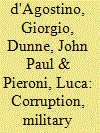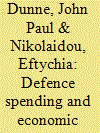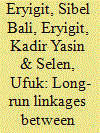|
|
|
Sort Order |
|
|
|
Items / Page
|
|
|
|
|
|
|
| Srl | Item |
| 1 |
ID:
116064


|
|
|
|
|
| Publication |
2012.
|
| Summary/Abstract |
This paper considers the effect of corruption and military spending on economic growth, analysing both the direct impact of public spending and the effect of allocating resources between categories of public spending within the framework of an endogenous growth model. The model exhibits non-linearities as a result of the links between the components of public spending, corruption and economic growth. The main findings of the empirical analysis confirm the expectation that corruption and military burden lower the growth rate of gross domestic product per capita. They also suggest that when the effect of the complementarity between military spending and corruption is omitted, as in most studies, the impact of military burden on economic performance is underestimated.
|
|
|
|
|
|
|
|
|
|
|
|
|
|
|
|
| 2 |
ID:
116060


|
|
|
|
|
| Publication |
2012.
|
| Summary/Abstract |
Over the last 30?years, there has been an impressive amount of empirical work on the defence-growth nexus, using different methodologies, models and econometric techniques and focusing on individual case studies, cross-country studies or panel data studies. Despite the number and the variety of studies, the evidence on the defence-growth relationship is still far from conclusive. Rather surprisingly, very limited work has been published in the relevant literature for the European Union despite the continuous discussions for a Common European Defence Policy that would require an assessment of the economic effects of defence in this region. To fill in the gap in the literature, this paper employs an augmented Solow-Swan model and estimates it both with panel and time series methods to provide empirical evidence on the economic effects of defence spending in the EU15 over the period 1961-2007. Overall, evidence derived from both panel and time series methods is consistent and suggests that military burden does not promote economic growth in this region.
|
|
|
|
|
|
|
|
|
|
|
|
|
|
|
|
| 3 |
ID:
116062


|
|
|
|
|
| Publication |
2012.
|
| Summary/Abstract |
In this study, we empirically investigate the long-run relationships between education-health expenditures, defence expenditures and economic growth in Turkey by using annual time-series data for the time period 1950-2005. To estimate these relationships, we use the cointegration method, which allows for the existence of structural breaks. The results show that there are two cointegrating vectors in the system with statistically significant structural breaks. According to the identified long-run equations, education and health expenditures affect economic growth positively, while defence expenditures have negative effects. In addition, the results show that there is a budgetary trade-off between education-health and defence expenditures.
|
|
|
|
|
|
|
|
|
|
|
|
|
|
|
|
| 4 |
ID:
116063


|
|
|
|
|
| Publication |
2012.
|
| Summary/Abstract |
Middle Eastern and North African (MENA) countries have been characterized by the preponderant role of their military forces in economic matters, as demonstrated by the high levels of military spending and the growing industrial complex. While extensive research examines the relationship between military expenditure and economic growth, little attention has been paid to the effect of military expenditure on economic inequality. Studying inequality in MENA countries provides an opportunity to assess factors that shape the countries' level of economic well-being, which has greater public policy implications in terms of how society allocates its scarce resources among competing needs. This paper examines two important issues. In the first part of the paper, we examine the relationship between military spending and inequality in MENA countries using a panel regression for country-level observations over the period 1987-2005. The empirical results indicate that military spending has a strong and negative effect on inequality. Contrary to the conventional wisdom, in MENA countries a systematic increase in military spending could reduce the level of inequality. In the second part of this paper, we examine the demand for military expenditure; we find that factors such as inequality level and per capita income negatively affect military expenditure.
|
|
|
|
|
|
|
|
|
|
|
|
|
|
|
|
| 5 |
ID:
116061


|
|
|
|
|
| Publication |
2012.
|
| Summary/Abstract |
This paper makes a contribution to the debate on the economic effects of military spending using a large cross-country panel data-set for 1988-2006. As well as providing a relatively up to date analysis, sub-groups are created that allow the analysis to focus on groups of countries at different income levels and Sub-Saharan Africa (SSA), an area which has seen a large number of damaging conflicts. Estimating the empirical growth model gives results that show variation across the sub-groups, with the general picture of significant negative short-run effect and insignificant long-run effect of military burden on per capita GDP growth, not consistent across the different income groups. In addition, breaking down the SSA group into those involved in conflict and those that are not, provides some further intriguing findings that suggest the value of further work on the impact of conflict on growth.
|
|
|
|
|
|
|
|
|
|
|
|
|
|
|
|
|
|
|
|
|